There are 50 different types of snakes in Alabama. While most of them are harmless, six are equipped with deadly venom. The wide range of habitats like marshes, swamps, grasslands and hills make it possible for many species to thrive.
Today many snakes can be found closer to home and in residential areas. Houses built near forests and nature areas make it common for snakes to be closer to humans.
Many snakes have adapted to this and often use humans as an advantage. A common example is rat snakes, living in barns and in farms to feed off the increased rodent populations.
Other snakes spend their time hiding under objects avoiding humans all together. Snakes found on this list can be very similar. Color, pattern, size and body shape are common ways to help identify one species from the next.
Each species also has its own preferable habit and range. Some snakes can be kept as pets and bred. On this list you will find all snakes found in Alabama to help you identify them on your next outing in nature.
Table of Contents
Snakes in Alabama
1. Copperhead
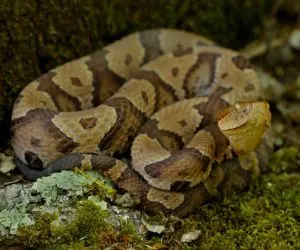
- Experience Level: Intermediate
- Family: Viperidae
- Scientific Name: Agkistrodon contortrix
- Other Names: Eastern Copperhead
- Adult Size: 20 to 37 inches
- Lifespan: 18 years
- Average Price Range: $100
Copperheads are a common pit viper found in North America. Their body is a pale brown with a light tan stomach to match the ground.
Creeping across the snake’s rough back sits a pattern of dark hourglass bands that run down to its tail. Facial structures include a broad head that covers its mouth, and a sloped nose.
Only active during daytime hours, copperheads roam many wooded and grassy areas of the Southern United States. While this snake is venomous, their short fangs make it rare for bites to be lethal.
Mammals like rabbits, mice and birds are what they feed on. These snakes have adapted to human presence and do not mind living near populated rural areas.
2. Cottonmouth
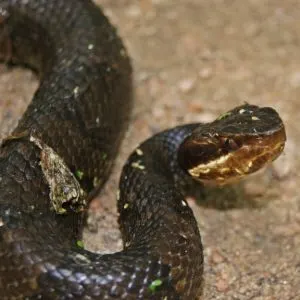
- Experience Level: Advanced
- Family: Viperidae
- Scientific Name: Agkistrodon piscivorus
- Other Names: Water Moccasin
- Adult Size: 24 to 48 inches
- Lifespan: 10 years
- Average Price Range: $150
Cottonmouths are large snakes easily identified by their white mouths. They are dark in color being brown, olive or black. On their back runs a dark crossband pattern that stretches to their lighter colored belly. As they age their color darkens, sometimes getting completely black.
These snakes live in grasslands, wet forests, and swamps, with large bodies of water for them to swim in. Out of all the venomous snakes found in North America the cottonmouth is the most aquatic.
Their venom is deadly and lets the snake eat a wide variety of mammals, and amphibians. Being pit vipers, they are equipped with heat sensing glands to track prey.
3. Timber Rattlesnake
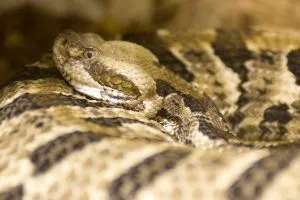
- Experience Level: Advanced
- Family: Viperidae
- Scientific Name: Crotalus horridus
- Other Names: Canebrake Rattlesnake, Banded Rattlesnake
- Adult Size: 36 to 60 inches
- Lifespan: 10 to 20 years
- Average Price Range: n/a
Timber Rattlesnakes are a venomous pit viper that can be found across the Southeastern United States. They live in a wide range of habitats like forests, mountains, swamps and other grassy areas.
Their bodies are grey with dark colored V shapes covering their body. A light colored stripe sits upon its back stretching to its tail. At the end of their tail is a rattle to alert threats, which can be brown or black in color.
In winter they hide in dens, but when summer comes along they travel long distances to find a mate. As temperatures rise they tend to avoid the sun, and winter is when they begin brumation.
Small birds, mammals and other reptiles are what they prey upon to survive. Timber Rattlesnakes can easily kill with their venom and should only be handled by professionals.
4. Pigmy Rattlesnake

- Experience Level: Advanced
- Family: Viperidae
- Scientific Name: Sistrurus miliarius
- Other Names: Ground rattlesnake, Hog-nosed rattlesnake
- Adult Size: 16 to 24 inches
- Lifespan: 20 years
- Average Price Range: $100
Pigmy Rattlesnakes are the smallest rattlesnakes found in Northern America. While still venomous, they have a weak bite and are only harmful for children or small animals.
This snake is usually light to dark grey, with black splotches on it. Occasionally a reddish to brown stripe can run down its back. Although they are active all day, their camouflage makes sighting one difficult.
A small tail and rattle help differentiate it from other rattlesnakes. A smaller and more “buzz” like sound comes from this snake when threatened. Pigmy rattlesnakes are not aggressive and will only bite if agitated.
They survive off smaller prey by tracking scent trails left behind. Younger snakes have a bright yellow tail, which they use to attract prey such as bugs.
5. Eastern Coral Snake
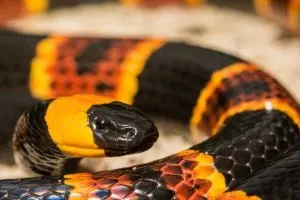
- Experience Level: Advanced
- Family: Elapidae
- Scientific Name: Micrurus fulvius
- Other Names: Common coral snake
- Adult Size: 18 to 30 inches
- Lifespan: 7 years
- Average Price Range: n/a
Eastern Coral snakes are highly venomous, and can be found in Alabama and other Southeastern states. It’s scales are smooth and its body is long.
The head of the snake is black and it’s body consists of red and black rings separated by yellow rings. Remembering that the red rings are always next to the yellow is a good way to identify it from other similar looking species.
Found in more tropical environments, they survive off small amphibians and other reptiles. Coral snakes can be found in suburb areas but are not likely a threat due to their timid nature.
These snakes rarely climb and like spending their time underground. They should only be handled by professionals since they are highly venomous and can kill with a bite.
6. Eastern Diamondback Rattlesnake
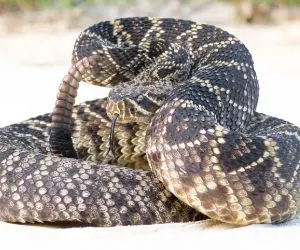
- Experience Level: Advanced
- Family: Viperidae
- Scientific Name: Crotalus adamanteus
- Other Names: Diamondback
- Adult Size: 4 to 5 feet long
- Lifespan: 15 to 20 years
- Average Price Range: $100
Eastern Diamondback rattlesnakes are known as being one of the heaviest venomous snakes, and is the largest rattlesnake species in North America.
They are extremely deadly, with one bite able to administer as much as 4x the lethal amount of venom. They inhabit the lower coastal plains and sandy mountain habitats in the southeastern United States.
Eastern diamondbacks have large bodies that are grey or brownish tan in color. Brown diamonds outlined in yellow cover most of its back. They can swim but will generally stay on land.
Diamondbacks survive off rats, bunnies and other small mammals. Using their curved fangs and pit sensors, they are effective hunters.
Biting is only done if threatened. While not an endangered species, random killings and the destruction of their habitat have dropped their population.
7. Worm Snake
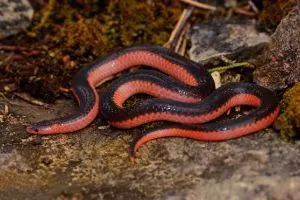
- Experience Level: Beginner
- Family: Colubridae
- Scientific Name: Carphophis
- Other Names: American worm snake
- Adult Size: 13 to 14 inches
- Lifespan: 4 years
- Average Price Range: $20
Worm snakes are small, worm-like snakes that can be found all across the U.S and Alabama. Usually brown and dark in color. Their stomachs are light pink or orange. Similar in appearance to other worm snakes, they have thin heads, small eyes and a sharp tail.
Their diet consists mainly of earthworms they find while digging through the ground, but they will eat other small insects. Sometimes small salamanders and lizards.
It is rare to see one of these snakes, as they spend most of their time buried in loose soil. Common predators include birds and other snakes.
8. Northern Scarlet Snake

- Experience Level: Advanced
- Family: Colubridae
- Scientific Name: Cemophora coccinea copei
- Other Names: Scarlett snake
- Adult Size: 14 to 20 inches
- Lifespan: 10 to 15 years
- Average Price Range: $100
Northern Scarlet snakes are small, usually found in open sandy forest areas. They are sometimes confused with coral snakes as they look similar but they are not venomous and safe.
It’s color is usually red with the option of black and yellow blotches with white rings. Their heads are small and their bodies are medium in size. They are found all across the southeastern U.S, in some states being considered endangered.
Scarlet Snakes are nocturnal and only active in summer. At night they hunt small creatures or search for eggs to eat. During the day they sleep, hiding under logs and brush to keep safe. Shy and timid they do not make the greatest pets, but capturing has contributed to their population decline.
9. Eastern Coachwhip

- Experience Level: Intermediate to advanced
- Family: Colubridae
- Scientific Name: Masticophis Flagellum
- Other Names: Whip snake
- Adult Size: 50 to 72 inches
- Lifespan: 12 to 20 years
- Average Price Range: $100 to $190
Coachwhips are very long and slender snakes, with large eyes that glow yellow. Most common coloration is a black head with a tan body. Their belly usually matches the color of their back. Younger snakes are equipped with bands going down their backs.
These snakes are found in hot and dry habitats. Active during the day, they eat a wide variety of insects, lizards and small mammals to survive. Coachwhips are extremely fast and use that speed to out maneuver predators.
These snakes require special handling and are not good for beginner snake owners. While they are not venomous they can be quick to bite.
10. Eastern Racer
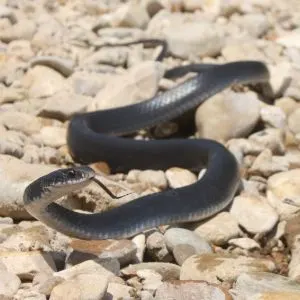
- Experience Level: Advanced
- Family: Colubridae
- Scientific Name: Coluber constrictor
- Other Names: Black Racer
- Adult Size: 20 to 60 inches
- Lifespan: 10 years
- Average Price Range: $40 to $60
Eastern Racers are found through the U.S and can have a wide variety of patterns. They can be found in black, blue, brown, tan or green, but all usually have a light yellow stomach.
Active during the day, they move fast to catch prey. Some are even seen climbing trees to eat eggs left by birds.
They can be found frequently near water, swamps, grassy areas and forests. In spring is when they are most active and can be seen in wide open areas.
They often lift their heads up to get a view with their excellent eyesight. These snakes are often mistaken for coachwhips but are smaller in size.
11. Ringneck Snake
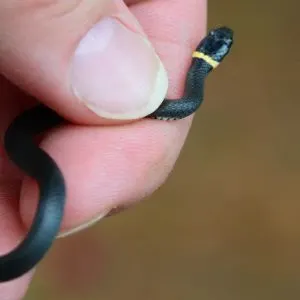
- Experience Level: Beginner
- Family: Colubridae
- Scientific Name: Diadophis punctatus
- Other Names: The ring-necked snake
- Adult Size: 10 to 16 inches
- Lifespan: 6 to 10 years
- Average Price Range: $40
Ringneck snakes are most well known for the orange or yellow ring that can be found around their neck. While some species do not have this, it is an easy way to identify them.
They are long and slender snakes usually grey in colour. They have orange bellies to match the ring on their neck.
While found in many habitats, this snake seems to prefer more wooded areas. Ringneck snakes are very popular pets due to their unique color, small size, and docile nature.
They feed off worms, slugs and small reptiles and amphibians to survive. To kill larger prey they will sometimes constrict it.
12. Eastern Indigo Snake
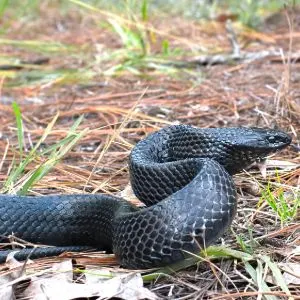
- Experience Level: Advanced
- Family: Colubridae
- Scientific Name: Drymarchon couperi
- Other Names: Blue indigo snake
- Adult Size: 5 to 6 feet
- Lifespan: 20 years
- Average Price Range: $1600 to $3000
Eastern Indigo snakes are a non venomous species found in the southeastern United States. They are all black, occasionally having orange coloring around their face and mouth.
Its diet includes other snakes, amphibians and small mammals. They are a protected species, so even handling it without a permit is illegal.
Eastern Indigo Snakes are the longest snakes in North America and are loved for their dark black-blue skin. These snakes can be found mostly in Florida but were originally in southern alabama.
Humans, with killing and destruction of their homes have completely eradicated the snake in its natural habitat. They were reintroduced in parts of Alabama to try and repopulate, and rare sightings sometimes occur.
13. Mudsnake
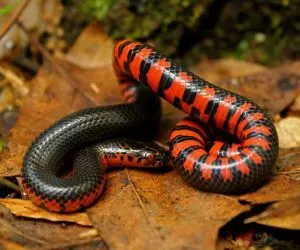
- Experience Level: Advanced
- Family: Colubridae
- Scientific Name: Farancia abacura
- Other Names: Checkered snake, Dart snake
- Adult Size: 40 to 54 inches
- Lifespan: 20 years
- Average Price Range: $90
Mudsharks can be found in the Coastal plains of western parts of Alabama and the United States. They are extremely docile and will refuse to bite. Its scales are smooth, with black coloring. On its bellies holds a checkered pattern of red and black.
They sometimes press their tongues against people, which is why some believed they could sting. Mud Snakes are aquatic and eat mostly amphibians.
These snakes are commonly not seen, as they are nocturnal and live in places where humans would normally not go. They breed in the spring and make their nest in wet mud. As winter comes along they may stay in their nest and not venture as much.
14. Rainbow snake
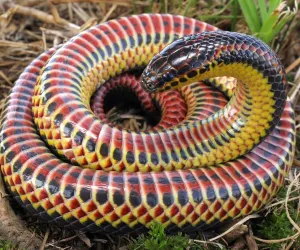
- Experience Level: Advanced
- Family: Colubridae
- Scientific Name: Farancia erytrogramma
- Other Names: n/a
- Adult Size: 36 to 48 inches
- Lifespan: 20 years
- Average Price Range: $100
Rainbow snakes are considered some of the most beautiful snakes in the U.S due to their coloring. They are black, with smooth scales and red dorsal stripes run down its body. Their bellies are a mix of red yellow and black scales.
These snakes are aquatic and nocturnal. Found in many aquatic habitats, most live in swamps, creeks and rivers. Not a lot is known about this snake due to its secretive nature.
They spend a lot of time hiding under cover, like vegetation or large objects. They are active all year round and lay their eggs in the middle of summer. Their diet consists of amphibians they find as they swim.
15. Eastern Hognose Snake
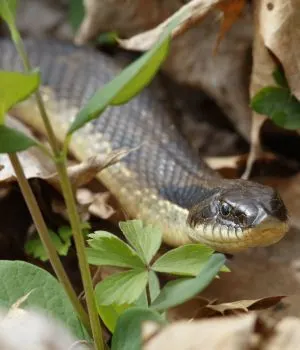
- Experience Level: Beginner
- Family: Colubridae
- Scientific Name: Heterodon platirhinos
- Other Names: Puff adder
- Adult Size: 20 to 33 inches
- Lifespan: 5 to 9 years
- Average Price Range: $150 to $250
Eastern Hognose snakes have upturned snouts, which is where they get their name from. They are large, with colorizations such as yellow, grey, brown, green or black.
They have brown splotches going down the middle of their back. Their large heads are the reason many people believe this snake to be deadly. Younger snakes are yellow in color with tan spots.
Eastern hognose snakes do produce a mild venom in the back fangs, but it can not harm humans. Often they can be found in sandy hills,meadows, forest and fields. Their main diet consists of toads but they can eat other small animals like frogs, mice and birds.
16. Southern Hognose Snake
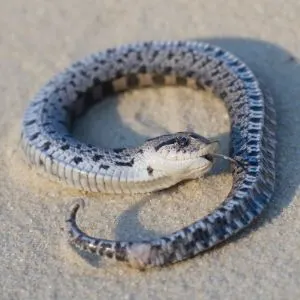
- Experience Level: Beginner
- Family: Colubridae
- Scientific Name: Heterodon simus
- Other Names: Hissing adder
- Adult Size: 13 to 21 inches
- Lifespan: 5 years
- Average Price Range: $150 to $250
Southern Hognose snakes are small with an up tilted nose. Unlike esastern hognose snakes they will never be solid black but can be grey, brown or green.
They are active during the day and come out during warm periods. Frogs and other small animals are what they eat but their diet is mostly toads. They are able to resist the toad’s venom and safely eat them.
Due to the loss of pinewood forests their population has declined drastically. They are rarely found in Alabama and are secretive, making it hard for them to be studied.
When threatened they do a plethora of displays, like playing dead, spreading their neck, and lunging without biting to ward off enemies.
17. Prairie KingSnake

- Experience Level: Beginner
- Family: Colubridae
- Scientific Name: Lampropeltis calligaster
- Other Names: Yellow-bellied Kingsnake
- Adult Size: 30 to 40 inches
- Lifespan: 12 to 30 years
- Average Price Range: $100 to $250
Prairie kingsnakes are tan, brownish and sometimes grey. Dark blotches go down its back and side usually outlined in black. On their head is sometimes a V or U shaped marking. As they age they tend to grow darker in color.
Like their name suggests, they live in prairies and open woods. They eat other snakes, and are immune to other snake’s venom. Their diet also consists of small rodents, birds and lizards.
They are mostly active in spring to summer, and become nocturnal as it gets hotter in the days. King Snakes are often used to control rodent populations, since they enjoy eating mice and rats.
18. Mole Kingsnake

- Experience Level: Beginner
- Family: Colubridae
- Scientific Name: Lampropeltis calligaster
- Other Names: Brown Kingsnake, Blotched Kingsnake, Mole catcher, House Snake
- Adult Size: 30 to 40 inches
- Lifespan: 15 years
- Average Price Range: $100 to $250
Mole Kingsnakes are smaller kingsnakes, likely to be around 4 feet. They are more rare and are found scattered throughout parts of northern Alabama.
Its base is brown with pink interlaced. Dark brown and red saddles go down its back. Its belly is lighter than the rest of its body, being a light cream color.
They are rare to see and very little is known about the species. Most of their time is spent underground, hiding in their burrows. When they are found above ground it is usually dark or raining.They feed off many small creatures found in open fields and forests.
19. Eastern Kingsnake

- Experience Level: Beginner
- Family: Colubridae
- Scientific Name: Lampropeltis getula
- Other Names: Common Kingsnake
- Adult Size: 36 to 48 inches
- Lifespan: 20 to 30 years
- Average Price Range: $100 to $250
Eastern Kingsnakes are a very common species that can be found all across America. They live in wide open areas like grassy lands, farms and mountains.
Being resistant to venom, they often eat other snakes as food. Amphibians, eggs, birds and small animals are commonly preyed upon by this snake.
Having them around is a good way to keep pest populations low. These snakes adapt well to captivity and are easily handled, making them great pets.
They can be seen having black shiny skin, with whit bands going around their body. Their bands can vary in size and sometimes be very thin, making the snake look all black.
20. Black Kingsnake
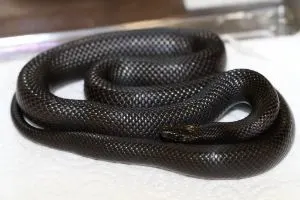
- Experience Level: Beginner
- Family: Colubridae
- Scientific Name: Lampropeltis getula nigrita
- Other Names: Mexican Black Kingsnake
- Adult Size: 48 to 58 inches
- Lifespan: 25 years
- Average Price Range: $100 to $250
The Black Kingsnake is a subspecies of the Common kingsnake that can be found throughout the U.S. It is all black with traces of white and yellow spots sprinkled throughout its body. It’s stomach is a lighter color, usually white.
Black kingsnakes live in forests, swamps, and marshlands. While they mainly live on land, they prefer to live close to a body of water. These snakes are most active during the day and hide under cover when they don’t want to be bothered.
A wide diet of eggs, snakes, fish, lizards and other small animals is what this snake survives off of. Like all Kingsnakes this creature will shake its tail when threatened and release musk. They are quick to bite but can be tamed easily, and make great pets.
21. Black Speckled Kingsnake
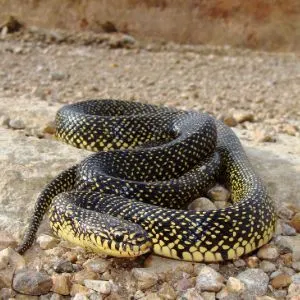
- Experience Level: Beginner
- Family: Colubridae
- Scientific Name: Lampropeltis holbrooki
- Other Names: Guinea Snake, Salt and Pepper Snake
- Adult Size: 48 inches
- Lifespan: 20 years
- Average Price Range: $100 to $250
The speckled king snake gets its name from the small white spots found at the center of each scale. It is a medium to large sized snake with glossy black skin.
They live in wet areas like swamps and near rivers. Found all across the central and southern U.S, occasionally they are seen exploring grassy fields and dry lands.
This snake has a varied diet of birds, lizards, other snakes and small mammals. It kills its prey by constructing and swallowing it. Kept as pets for their unique colors and calm nature, they are often bred in captivity and are not endangered.
22. Scarlet Kingsnake
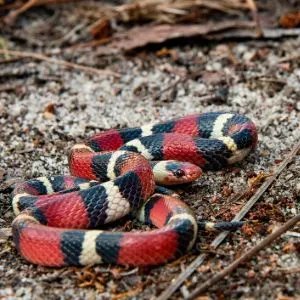
- Experience Level: Beginner
- Family: Colubridae
- Scientific Name: Lampropeltis elapsoides
- Other Names: Scarlet Milksnake
- Adult Size: 14 to 20 inches
- Lifespan: 20 to 30 years
- Average Price Range: $100 to $250
Scarlet Kingsnakes can be found in the southeastern and eastern parts of the United States. They can live in dry areas, forests and wet pinelands. Scarlet kingsnakes are small and have thin bodies.
They have a pattern of red, black and white with yellow bands going down its body. When born their banding is white, black and red but as they age it turns to yellow.
These snakes are rarely seen since they are nocturnal and tend to be more timid. During spring or times of rain they like to hide under debris like rocks or branches. This snake closely resembles the venomous coral snake, but is not harmful.
23. Red Milk Snake
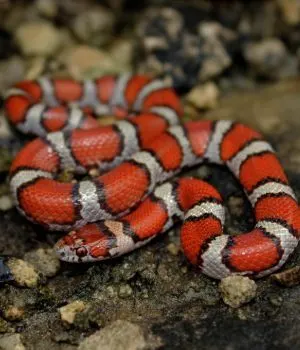
- Experience Level: Beginner
- Family: Colubridae
- Scientific Name: Lampropeltis triangulum
- Other Names: Milk Snake
- Adult Size: 24 to 35inches
- Lifespan: 15 years
- Average Price Range: $60 to $150
Red Milk snakes are a species of Kingsnake found in southern parts of the U.S. They average about 30 inches and have medium size bodies.
Their bodies are mostly red and white with rings going down its body that have black edging. On their head is usually a large red blotch with black edges.
They are called milk snakes because they are often found in barns, and are joked to suck the milk out of cows. Milk Snakes live in dry open areas and take shelter under debris like rocks or logs. It’s shy nature makes it hard to find in nature since they avoid humans. In spring is when they are most active and mate.
24. Eastern Milk Snake
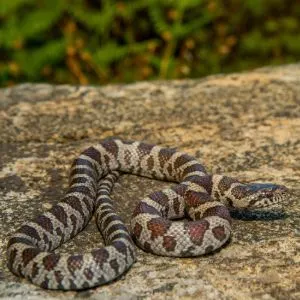
- Experience Level: Beginner
- Family: Colubridae
- Scientific Name: Lampropeltis triangulum
- Other Names: Milk Snake
- Adult Size: 24 to 36 inches
- Lifespan: 15 to 20 years
- Average Price Range: $60 to $150
Eastern milk snakes are grey with red blotches covering their bodies. On their belly lays a checkered pattern of black and white, and on their heads is a y shaped spot.
The habitats they dwell in include hills, mountains and farmlands through the Eastern parts of the United States.
These Snakes are often mistaken for Copperheads and killed, but they are harmless creatures. Milk snakes are secretive and are rarely seen.
They spend most of their time hiding under debris like logs and leaves. At night is when they hunt mice and small mammals. Suffocating and killing their prey by constriction.
25. Rough Green Snake
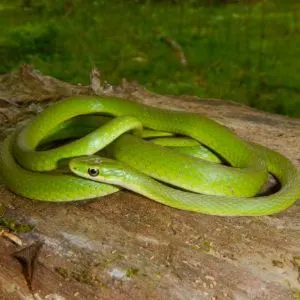
- Experience Level: Intermediate
- Family: Colubridae
- Scientific Name: Opheodrys aestivus
- Other Names: Grass Snake
- Adult Size: 22 to 32 inches
- Lifespan: 15 years
- Average Price Range: $10
Rough Green snakes inhabit meadows and woodlands in the southwest United States. Their bright green bodies make it easy to blend in with common grass and leaves which help to avoid predators like birds and other snakes. Long and slender, their bellies are a bright yellow.
Climbing and swimming are some of the snake’s strong suites, often found in low lying vegetation or in water. Since Rough Green snakes are smaller in size they survive off a diet of insects and small frogs.
These shy snakes need to be comfortable in their environment if kept as a pet. They are easily stressed out and need a calm, quiet environment to thrive. In nature they are often found hiding under logs or in brush.
26. Red Cornsnake
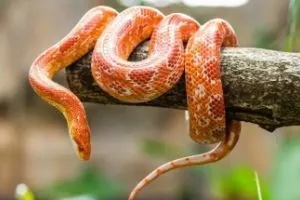
- Experience Level: Beginner
- Family: Colubridae
- Scientific Name: Pantherophis guttatus
- Other Names: Corn snake, Chicken snake
- Adult Size: 4 to 5.5 feet long
- Lifespan: 6 to 8 years
- Average Price Range: $80 to $150
Red corn Snakes are a species of rat snake found in southeastern and central United States. Found near corn storage and crops, this snake is very useful in keeping rodent populations in control.
They are similar in appearance to copperheads, but are brighter colored and not venomous. Their bodies are long and slender. Colored with orange and red blotches. Also on their head there is a spear shaped pattern.
Habitats where they are commonly found are swamps, hardwood hammocks and farms. Corn snakes are popular pets and easy to breed. They may bite but if handled properly they are quite calm.
27. Gray Ratsnake
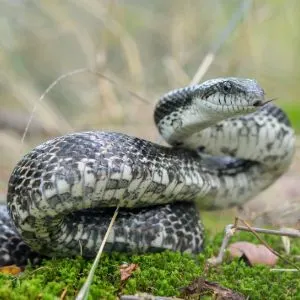
- Experience Level: Beginner
- Family: Colubridae
- Scientific Name: Pantherophis spiloides
- Other Names: Central ratsnake, pilot black snake,
- Adult Size: 3 to 6 feet long
- Lifespan: 10 to 15 years
- Average Price Range: $60
Grey rat snakes are all grey, with darker grey blotches on their bodies. These snakes look similar in appearance no matter the age. Grey Ratsnakes can be commonly found in forest areas, on the ground or in trees.
Rat Snakes are a strong constrictor snake that preys on small mammals like birds and rats. If you find this snake in the wild they freeze, sometimes shaking their tail to make a small buzzing sound.
Docile tempers and small size make them a popular pet. They are good for beginners since they are one of the most low maintenance snakes to own.
28. Black Pinesnake
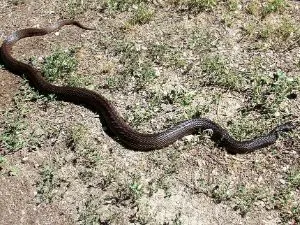
- Experience Level: Intermediate
- Family: Colubridae
- Scientific Name: Pituophis melanoleucus
- Other Names: Pine Snake, Bullsnake, Chicken snake
- Adult Size: 5 to 6 feet long
- Lifespan: 20 years
- Average Price Range: $200 to $400
The Black Pine Snake is one of the three species of Pine Snake found in North America. Midnight black skin and shiny bellies makes them easy to distinguish. While they do look all black, if looked at closely they can have brown bands around their body.
In the wild it is rare to see them. They can be found in the coastal plain environments and forests. Destruction of the pine forests have made this specie’s numbers dwindle, as that is where they normally live. Luckily these snakes are easily kept and bred in captivity. A diet of mice and eggs keeps them healthy.
29. Northern Pine Snake
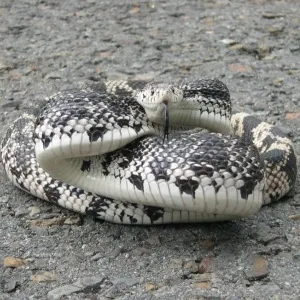
- Experience Level: Intermediate
- Family: Colubridae
- Scientific Name: Pituophis melanoleucus melanoleucus
- Other Names: Pine snake, Bull snake
- Adult Size: 5 to 6 feet
- Lifespan: 20 years
- Average Price Range: $200 to $400
Northern Pine Snakes have small, pointed heads with robust bodies. They are light grey with a variety of brown, to reddish brown blotches on their back. Dry sand forests with pine trees are where they make home. Sandy soil is where they burrow, spending most of their time underground.
Rodents and other small mammals are what feeds this large snake. They target mouse and gopher holes, sometimes killing an entire family of rodents for food. Destruction of forest and humans make this species endangered and close to being threatened. Nameless killings by humans is also another reason for their decline.
30. Florida Pine Snake

- Experience Level: Beginner
- Family: Colubridae
- Scientific Name: Pituophis melanoleucus mugitus
- Other Names: Pine Snake
- Adult Size: 84 inches
- Lifespan: 20 years
- Average Price Range: $200 to $400
Florida Pine Snakes are one of the largest snakes that live in North America. Pine flat woods, sandy forests and large grasslands is where they live. Their heads are small with a pointed snout.
Different colorations include white, yellow and light grey. They are covered by dark splotches that get lighter towards the tail.
Gopher turtle holes in sandy areas are a good place to find them, as they feed off them and are found in the same area. Destruction of forests has given this species less places to live and cut them down in numbers.
The targeting of gopher holes to kill rattlesnakes has also contributed in making this species threatened. While they can be found in Florida and parts of the south, they are not easy to find.
31. Pine Woods Littersnake
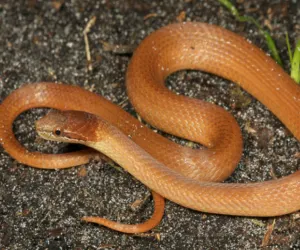
- Experience Level: Beginner
- Family: Colubridae
- Scientific Name: Rhadinaea flavilata
- Other Names: Yellow lipped snake, brown headed snake
- Adult Size: 10 to 13 inches
- Lifespan: 3 years
- Average Price Range: n/a
Pinewoods litter snakes are a small species known for being secretive, that live in Southeastern parts of the United States. Colors can range from brown, yellow or dark orange. Their bellies are white or lighter colored and their lips are white to yellowish.
Pinewoods and other forests are where these snakes live, hiding under leaves, rocks and logs. Areas with lots of leaf coverage are prime living locations. Their diet consists of small lizards, frogs and worms.
They prefer warmer climates and are active until winter. These snakes are not aggressive and are not likely to bite. When scared they emit a foul smell from their glands at the end of their tail.
32. Brownsnake

- Experience Level: Beginner
- Family: Colubridae
- Scientific Name: Storeria dekayi
- Other Names: Storeria
- Adult Size: 12 inches
- Lifespan: 7 years old
- Average Price Range: $30
Brown Snakes are small snakes found in the Southeastern parts of North America. Common colors can range from grey to brown.
They have a spotted pattern on their back with a yellow hue on it. This species survives off slugs, snails and earthworms. Their unique jaws help remove the shells from their prey.
Found in swamps, forests and grasslands they can sometimes live near suburbs. Most of the time this snake does not want to be seen and hides under debris like leaves, logs and rocks.
These snakes make excellent pets as they are small and docile. They are rare to bite and their diet makes them easy to feed.
33. Northern Red-bellied Snake
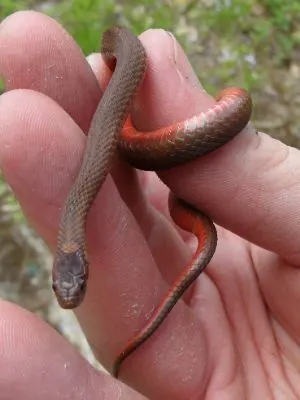
- Experience Level: Beginner
- Family: Colubridae
- Scientific Name: Storeria occipitomaculata occipitomaculata
- Other Names: Fire snake
- Adult Size: 12 inches
- Lifespan: 4 years
- Average Price Range: $50
Northern red bellied snakes come in many shades, sometimes being brown , grey, orange and even black.They are most well known for their bright red bellies.
They are a small sub species of storeria and only live up to 4 years. Often they can be seen in flower beds and gardens feeding off slugs and worms.
Habits these snakes prefer are coastal plains and wetlands, but they can be throughout eastern forests and all around Alabama.
Areas with moist shaded habitats with lots of ground cover is a common place to find them. In some states they are protected and more rare to see. They can be seen hiding under rocks and other objects.
34. Southeastern Crowned Snake
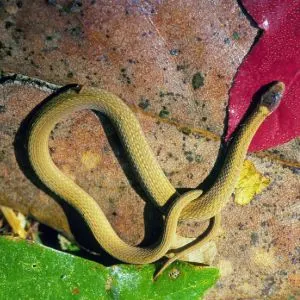
- Experience Level: Beginner
- Family: Colubridae
- Scientific Name: Tantilla coronata
- Other Names: Tantilla snake
- Adult Size: 8 to 10 inches
- Lifespan:
- Average Price Range: $50
Southeastern crowned snakes are small and thin creatures. Their bodies range from different shades of brown and their belly is pink. They have tiny pointy heads painted in black and two rings sit upon its neck, black and brown.
This snake can be found all through Alabama and the south in damp or dry wooded areas. A common place to find them is under rocks, logs and other natural debris.
They are nocturnal and feed off bugs and invertebrates. Crown snakes are not deadly and only produce a harmless venom. Insects are the main food in their diet. Early spring is when they go out to mate. In some states they are a protected species and rare to find.
35. Eastern Ribbon Snake
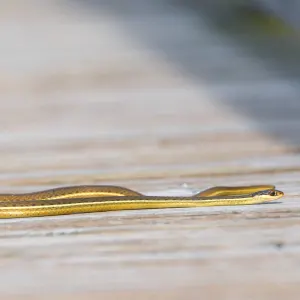
- Experience Level: Beginner
- Family: Colubridae
- Scientific Name: Thamnophis sauritus
- Other Names: Ribbon snake
- Adult Size: 18 to 34 inches
- Lifespan: 20 to 30 years
- Average Price Range: $75 to $120
Eastern ribbon snakes are a small non venomous species, usually with a dark base color. Its body is long and slender and its head is small and fit with large eyes. Three stripes go along its side and back and their belly is a plain yellow.
Ribbon snakes can be found in the water or on land. They survive off a diet of mostly fish and amphibians. These snakes prefer pinelands prairies, forests, grassy habitats and grassy areas with water.
Active during the day, they will flee if approached. It is rare for them to bite, which makes them popular and good pets for beginners.
36. Eastern Garter Snake
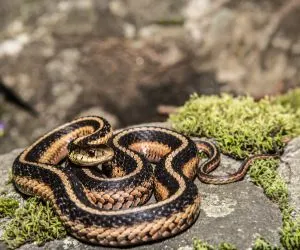
- Experience Level: Beginner
- Family: Colubridae
- Scientific Name: Thamnophis sirtalis sirtalis
- Other Names: n/a
- Adult Size: 18 to 26 inches
- Lifespan: 4 years
- Average Price Range: $25
Eastern garter snakes can come in many colors like grey, blue and tan. They can be distinguished by their yellow stripes going down their body, and usually have a checkered pattern with dark blotches on it. This species is similar in appearance to ribbon snakes, but they have a more robust body.
Meadows, marshes, woodlands and hill sides is where these snakes can be found. They inhabit most of the United States and the Southeast.
Areas with water and natural debri is a popular place they like to hang around, being active in the day or night. They survive off of slugs, frogs and small animals. In winter eastern garter snakes hibernate and come out during spring to mate. Unlike other snakes they give birth to live young, and not eggs.
37. Rough Earth Snake
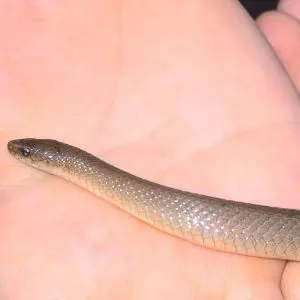
- Experience Level: Advanced
- Family: Colubridae
- Scientific Name: Haldea striatula
- Other Names: Brown ground snake
- Adult Size: 7 to 12 inches
- Lifespan: 7 years
- Average Price Range: n/a
Rough Earth snakes are small creatures, usually brown or reddish brown in color. Its stomach is usually yellow or light colored, and fades into its body. They have pointed snouts and keeled scales.
These snakes can be found abundantly in the Coastal Plain environments and grassy regions of Alabama and southeastern United States.
They spend most of their time underground and are most active from spring to late summer. Usually they can be found Hiding under rocks, trees and leaves.
Being smaller snakes they survive on small insects like worms, slugs, snails and frogs . Predators includes other snakes and birds.
38. Western Smooth Snake

- Experience Level: Intermediate
- Family: Colubridae
- Scientific Name: Macroprotodon brevis
- Other Names: Western false smooth snake
- Adult Size: 24 inches
- Lifespan: 6 years
- Average Price Range: $75
Western smooth snakes are small snakes with a heavy build. Common colors include grey, light brown and reddish brown. This snake does not have any distinctive pattern, but some snakes have small black spots scattered on their body. Their belly is a white cream color.
Rocky and vegetation dense forest and hills is where they typically live. This snake prefers privacy . It spends most of its time underground or hiding under rocks and debris.
Warmer climates are preferred and they are most active at night. Small insects like worms and slugs fuel this snake. It is not common to find these snakes often, and in some states like Georgia they are a protected species.
39. Eastern Smooth Snake
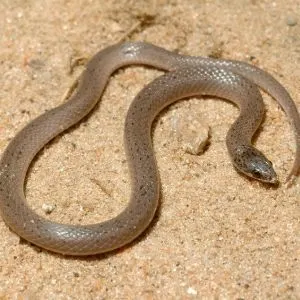
- Experience Level: Intermediate
- Family: Colubridae
- Scientific Name: Virginia valeriae
- Other Names: Blaney’s snake, Brown worm snake
- Adult Size: 7 to 10 inches
- Lifespan: 20 years
- Average Price Range: $75
The eastern smooth snake’s colors can range from reddish brown to dark grey. They are small with a thin body and light colored stomachs.
Occasionally a faint stripe can run down its back or small black spots can appear on their body. Generally they have no markings on them. These snakes are secretive and rare to see, but some scientists think they are more common than previously thought.
Eastern smooth snakes spend most of their time underground. When they venture above ground it is common to find them hiding under rocks and debris. They hunt and eat mostly bugs and small mammals like shrews. These snakes can become prey to other predators like snakes and birds.
40. Gulf Saltmarsh Snake

- Experience Level: Intermediate
- Family: Colubridae
- Scientific Name: Nerodia clarkii clarkii
- Other Names: n/a
- Adult Size: 15 to 30 inches
- Lifespan: 20 years
- Average Price Range: $123
Gulf Saltmarsh snakes can be found in the salt marshes of the United States. They are medium sized with a total of six stripes running across its body.
The stripes are yellow and light tan, with their bodies being dark in color. Common predators include egrets, herons and crabs. These snakes eat small fish and invertebrates to survive.
Since there is no fresh water where they live, they rely on the water in what they eat to hydrate. At night is when they venture out and during the day they like to hide under bushes and natural cover.
The destruction of their habitat has made this snake’s population decline. They are also killed for being mistaken for cottonmouths, even though they are not venomous.
41. Mississippi Green Water Snake
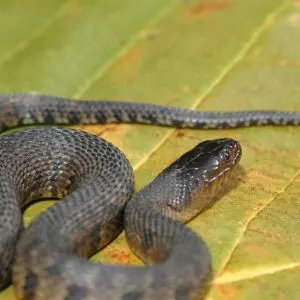
- Experience Level: Beginner
- Family: Colubridae
- Scientific Name: Nerodia cyclopion
- Other Names: Green water snake
- Adult Size: 30 to 55 inches
- Lifespan: 9 years
- Average Price Range: $20
Mississippi Green water snakes are medium sized with thick dark greenish bodies. Dark markings appear on its back and fade as the snake ages. Juvenile snakes are similar to adults, but their markings are much more prominent.
Their stomachs are grey and are plastered with crescent shaped marks. A distinguishable feature is the row of scales between the eyes and lips.
These snakes live in lakes, ponds, marshes and bayous feeding off the local aquatic life. These snakes give birth to live young, which look similar in appearance to their adult counterparts. These snakes are not dangerous or venomous and make great pets if given the right space to live in.
42. Plain-bellied Water Snake
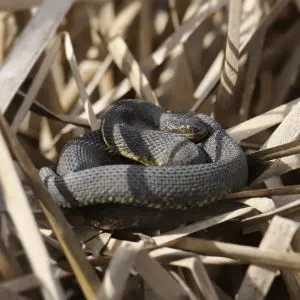
- Experience Level: Beginner
- Family: Colubridae
- Scientific Name: Nerodia erythrogaster
- Other Names: Plainbelly water snake
- Adult Size: 30 to 48 inches
- Lifespan: 9 years
- Average Price Range: $40
Plain belly water snakes can be found in the Southeastern United States near large bodies of water. Sometimes they choose to travel away from water during humid periods. They are large and thick.
Their colors can vary from gray, tan, or olive green with red coloring under their mouths. Dark blotches are common on this snake and their underside is usually yellow, brown, red or green with no markings.
Plainbelly water snakes are often confused with cottonmouths but they are not venomous. They can be found basking in the sun and hanging from branches. Their diet is mostly of frogs and tadpoles, sometimes fish. This snake is active during both day and night.
43. Southern Water Snake

- Experience Level: Beginner
- Family: Colubridae
- Scientific Name: Nerodia fasciata
- Other Names: Banded water snake
- Adult Size: 34 to 60 inches
- Lifespan: 9 years
- Average Price Range: $20 to $100
Southern Water Snakes are medium sized, thick snakes that are found in the Southeastern United states. Mostly in the coastal plains habitat. Their base color can be grey, tan, yellow or reddish brown and they darken with age. On their back lays a dark crossband pattern and occasionally a black line runs down their back.
These snakes are semi aquatic, and can be found in areas with large bodies of water. They feed off of frogs, fish, birds, and whatever small animal they can find.
Mostly active at night, they are not venomous or dangerous to humans. Water snakes make great pets as they are inexpensive and easy to care for.
44. Florida Green Water Snake
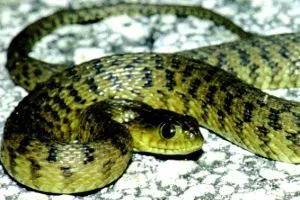
- Experience Level: Advanced
- Family: Colubridae
- Scientific Name: Nerodia floridana
- Other Names: Congo Snake, Florida water snake
- Adult Size: 30 to 55 inches
- Lifespan: 9 years
- Average Price Range: $20
Florida Green Watersnakes live in the south waterways and are commonly found southwestern areas of Alabama. Vegetation and still water is where they prefer to be.
Places like Bayous, lakes, swamps, marshes and ponds make perfect habitats. They are thick, with dark green, olive or brown skin. Sometimes it can be reddish or brown.
A key difference between them and other watersnakes is the scales that appear around the eyes. It looks as if a ring of plates is around the eyes, since there are one or two scales that are placed there.
Their diet consists of frogs, fish and small creatures. These snakes are active during the day and can be quick to bite.
45. Diamond backed Water Snake
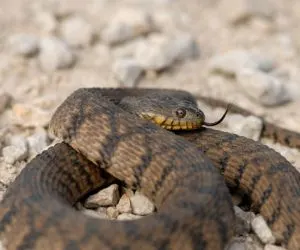
- Experience Level: Intermediate
- Family: Colubridae
- Scientific Name: Nerodia rhombifer
- Other Names: Northern Diamond backed water snake
- Adult Size: 30 to 48 inches
- Lifespan: 9 years
- Average Price Range: $40
Diamondback water snakes are medium sized, with greyish to brown bodies. Their scales are more keeled than other snakes, and they have a dark chain-like pattern running down it’s entire back. Younger snakes look similar in appearance to adults.
This snake is found in the central United States, and is very common. They usually live near slow moving water. It survives off a diet of fish and small animals.
A common way it hunts is by hanging from a tree and dipping into the water. Their teeth are sharp, which help hold onto fish. This can cause an extremely painful bite, but they are not dangerous.
46. Queen Snake
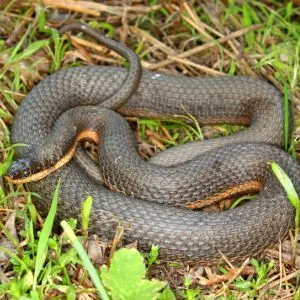
- Experience Level: Beginner
- Family: Colubridae
- Scientific Name: Regina septemvittata
- Other Names: Banded water snake
- Adult Size: 24 inches
- Lifespan: 19 years
- Average Price Range: $35
Queen Snakes are a non venomous water snake found in the southern parts of the U.S and Alabama. It is a smaller and thinner snake, with olive, gray, or dark brown skin.
Peach or yellow colored stripes run down the sides of its body. When they are young they have extra stripes, which usually disappear as they age.
These snakes prefer running water that is clean, and has rocky areas to hang around. It searches for its food by smell, and survives mostly on crayfish.
This snake is active during the day and during winter they brumate. Queen snakes are docile and can be handled easily. They scare easily and will run before biting.
47. Midland Water Snake
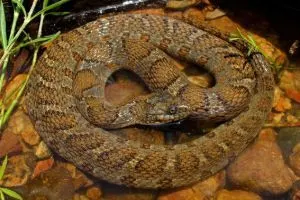
- Experience Level: Intermediate
- Family: Colubridae
- Scientific Name: Nerodia sipedon pleuralis
- Other Names: Common water snake
- Adult Size: 22 to 40 inches
- Lifespan: 9 years
- Average Price Range: $20
Midland water snakes are a medium sized aquatic snake, located in the Southern United States. It is brown, with dark blotches going down it’s back which form a checkered pattern as it gets to the tail.
On the snake’s stomach is a crescent shaped pattern that gives it stripes. It’s round eyes and thin body can also help identify it.
This snake lives in wetlands, marshes and swamp habitats, feeding off the aquatic life. This snake can be found in the northern parts of Alabama and is the most common water snake in that area. They are not venomous, but will not hesitate to bite.
48. Brown Water Snake
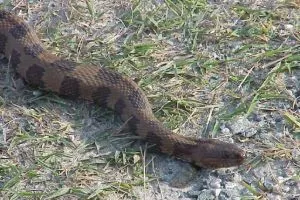
- Experience Level: Intermediate
- Family: Colubridae
- Scientific Name: Nerodia taxispilota
- Other Names: Water pilot, aspic, false moccasin
- Adult Size: 30 to 60 inches
- Lifespan: 9 years
- Average Price Range: $10 to $25
Brown water snakes dwell in the coastal plains and piedmont environments of the Southeastern United States. They are semi aquatic and frequent areas with lots of water.
Oftentimes they can be seen hanging from tree branches enjoying the warmth of the sun. Catfish are their main source of food, but they eat a variety of fish and amphibians.
Atop their wide heads sit their nostrils and eyes, which make it easier to navigate in water and breath. It’s body is painted light brown, with dark square blotches spread across its body.
When threatened they will not hesitate to bite and can emit a musky scent to ward off enemies. Luckily these snakes are not venomous but they are often mistaken for water moccasins.
49. Black Swamp Snake

- Experience Level: Advanced
- Family: Colubridae
- Scientific Name: Seminatrix pygaea
- Other Names: black swampsnake, mud snake, red-bellied mud snake, and swamp snake
- Adult Size: 10 to 15 inches
- Lifespan: 12 to 30 years
- Average Price Range: $50 to $100
Black swamp snakes are small aquatic snakes found in wetlands, swamps and many other bodies of water in the southeastern United States. Their skin is a beautiful black, which shines a calm darkness.
Their bellies are brightly colored in shades of orange and red. While young they are about 2 inches and have no coloration difference to their adult counterparts.
These snakes are very secretive and rarely seen. Large vegetation and debri near water edges are favored as hiding spots. In murky water with lots of plants they can be hard to see, making it easy to sneak up on prey.
Frogs, tadpoles and salamanders are some of their favorite meals. While they live in water, research has shown they are resilient to droughts. Feeding during pregnancy helps these snakes maintain population.
50. Glossy Crayfish Snake

- Experience Level: Beginner
- Family: Colubridae
- Scientific Name: Regina rigida
- Other Names: Glossy swamp snake, Glossy water snake
- Adult Size: 14 to 24 inches
- Lifespan: 20 years
- Average Price Range: $40
Glossy Crayfish Snakes are mid-sized aquatic snakes, with fairly thick bodies. Their heads are short and their eyes large. It’s scales are shiny and base colors can be brown or olive.
The underside varies from yellow to orange. Two faint stripes appear on the body and it’s belly is filled with dark spots.
This snake’s diet is mostly crayfish and it’s chiseled shaped teeth help it get through the hard shells. Instead of constricting, this snake uses its coils to hold down its prey.
It is a rare sight to see this snake. Most live near coastal plains in ponds and creeks. In some states this snake is protected and very little is known since it avoids humans.
Wrapping Up
Alabama is home to 50 different unique snakes that can be found across the variety of habitats the state holds. One of the main things that threaten all of these species is the destruction of their natural habitat. As people expand further into their territory it can cause many snakes to be uprooted from their homes.
Another common factor for some of these snakes is people killing them. Water snakes and other land snakes are often thought to be their deadlirer counterparts, and are killed for that reason. More knowledge on these species and local snakes that live around humans can help save many of their lives.
When herping, a list like this can help you stay safe and identify the species that live near you. Another reason for this list is to find different snakes that can make great pets. Owning snakes as pets can help keep many populations thriving. While some are captured, many are bred in captivity and help keep species numbers high.
It is important to research any snake you want to keep as a pet, and not uproot it from its home if it is endangered. Snakes are beautiful creatures and should always be respected when seen in nature.
Snakes in other states
